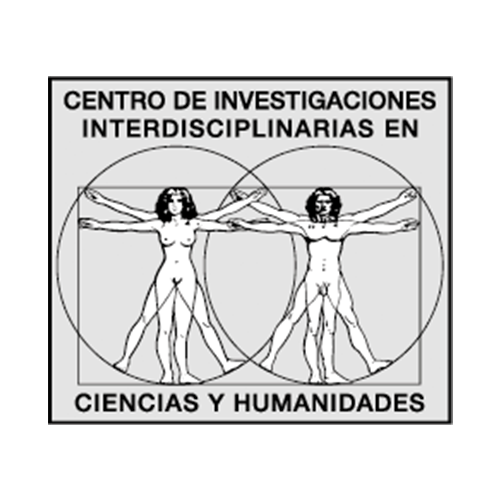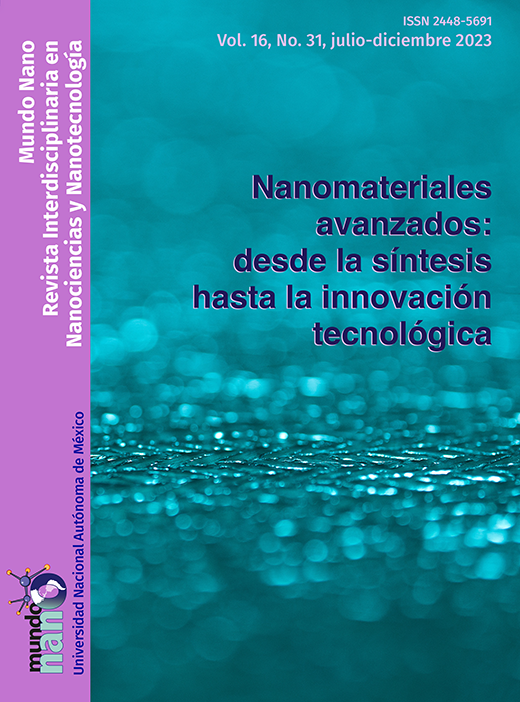Extracción de quitina de Aspergillus niger asistida por ondas de choque: caracterización fisicoquímica y eléctrica
Contenido principal del artículo
Resumen
La quitina es un polisacárido lineal producido por especies animales y fúngicas. Una de sus principales fuentes de obtención es el hongo Aspergillus niger, cultivado en biorreactores industriales. Es un biopolímero neutro que modifica las propiedades eléctricas de los materiales compuestos, una característica muy útil para algunos dispositivos electrónicos. Nuestro objetivo en este trabajo fue la caracterización fisicoquímica de películas de quitina, extraída de dicho hongo por un método químico asistido por ondas de choque y calor, así como también determinar su resistividad eléctrica al aplicarle altos voltajes (entre 10 y 20 kV). Las ondas de choque se utilizaron en este estudio porque se sabe que inducen poros en las células y podrían promover la entrada de álcali en la hifa, permitiendo una mejor eliminación de los componentes celulares residuales. La quitina fue neutralizada, secada y se formaron películas. Los valores de proteína residual se cuantificaron con la técnica de ácido bicinconínico (BCA), obteniendo películas con bajas cantidades de proteína. La caracterización del morfotipo específico extraído se estimó mediante infrarrojo transformado de Fourier (FTIR) y difracción de rayos X (XRD). Para evaluar la resistividad ante voltajes elevados, se diseñó un circuito especial que permitió detectar variaciones significativas de esta con respecto al voltaje aplicado, es decir, la quitina mostró un comportamiento coincidente con un varistor no lineal y, hasta donde sabemos, este es el primer informe de dicho comportamiento para la quitina.
Descargas
Detalles del artículo

Mundo Nano. Revista Interdisciplinaria en Nanociencias y Nanotecnología, editada por la Universidad Nacional Autónoma de México, se distribuye bajo una Licencia Creative Commons Atribución-NoComercial 4.0 Internacional.
Basada en una obra en http://www.mundonano.unam.mx.
Citas
Aylanc, Volkan, Seymanur Ertosun, Lalehan Akyuz, Behlul Koc Bilican, Semih Gokdag, Ismail Bilican, Yavuz Selim Cakmak, Bahar Akyuz Yilmaz y Murat Kaya. (2020). Natural β-chitin-protein complex film obtained from waste razor shells for transdermal capsaicin carrier. International Journal of Biological Macromolecules, 155: 508-515. https://doi.org/10.1016/j.ijbiomac.2020.03.232. DOI: https://doi.org/10.1016/j.ijbiomac.2020.03.232
Baird, David C. (1994). Experimentation: an introduction to measurement theory and experiment design, 3a ed. rev. EUA: Addison-Wesley Professional.
Cárdenas, Galo, Gustavo Cabrera, Edelio Taboaday S. y Patricia Miranda. (2004). Chitin characterization by SEM, FTIR, XRD, and 13C cross polarization/mass angle spinning NMR. Journal of Applied Polymer Science, 93(4): 1876-1885. https://doi.org/10.1002/app.20647. DOI: https://doi.org/10.1002/app.20647
Crini, Grégorio. (2019). Historical review on chitin and chitosan biopolymers. Environmental Chemistry Letters, 17: 1623-1643. https://doi.org/10.1007/s10311-019-00901-0. DOI: https://doi.org/10.1007/s10311-019-00901-0
Cuong, Hoang Ngoc, Nguyen Cong Minh, Nguyen Van Hoa y Trang Si Trung. (2016). Preparation and characterization of high purity β-chitin from squid pens (Loligo chenisis). International Journal of Biological Macromolecules, 93(A): 442-447. https://doi.org/10.1016/j.ijbiomac.2016.08.085. DOI: https://doi.org/10.1016/j.ijbiomac.2016.08.085
Chen, Yong-Ming, Sami Pekdemir, Ismail Bilican, Behlul Koc-Bilican, Betul Cakmak, Asad Ali, Lian-Sheng Zang, M. Serdar Onses y Murat Kaya. (2021). Production of natural chitin film from pupal shell of moth: Fabrication of plasmonic surface for SERS-based sensing applications. Carbohydrate Polymers, 262: 117909. https://doi.org/10.1016/j.carbpol.2021.117909. DOI: https://doi.org/10.1016/j.carbpol.2021.117909
Choi, M. J., A. J. Coleman y J. E. Saunders. 1993. The influence of fluid properties and pulse amplitude on bubble dynamics in the field of a shock wave lithotripter. Physics in Medicine and Biology, 38: 1561-1573. https://doi.org/10.1088/0031-9155/38/11/002. DOI: https://doi.org/10.1088/0031-9155/38/11/002
Cleveland, Robin O. y James A. McAteer. (2007). The physics of shock wave lithotripsy. En Arthur D. Smith, Gopal H. Badlani, Demetrius H. Bagley, R. V. Clayman, S. G. Docimo, Gerald H. Jordan, Louis R. Kavoussi, Benjamin R. Lee, James E. Lingeman, Glenn M. Preminger y J. W. Segura (eds.), Smith’s textbook on endourology. Hamilton, Ontario, Canadá: BC Decker, Inc., 317-332.
Farinha, Inês, Paulo Duarte, Ana Pimentel, Evgeniya Plotnikova, Bárbara Chagas, Luís Mafra, Christian Grandfils, Filomena Freitas, Elvira Fortunato y María A. M. Reis. (2015). Chitin-glucan complex production by Komagataella pastoris: Downstream optimization and product characterization. Carbohydrate Polymers, 130: 455-464. https://doi.org/10.1016/j.carbpol.2015.05.034. DOI: https://doi.org/10.1016/j.carbpol.2015.05.034
He, Jinliang. (2019). Introduction of varistor ceramics. En Jinliang He (ed.), Metal oxide varistors: From microstructure to macro-characteristics, 1-22. Weinheim, Germany: Wiley-VCH. DOI: https://doi.org/10.1002/9783527684038.ch1
Hirano, Shigehiro. (1996). Chitin biotechnology applications. Biotechnology Annual Review, 2(C): 237-258. https://doi.org/10.1016/S1387-2656(08)70012-7. DOI: https://doi.org/10.1016/S1387-2656(08)70012-7
Jang, Mi-Kyeong, Byeong-Gi Kong, Young-Il Jeong, Chang Hyung Lee y Jae-Woon Nah. (2004). Physicochemical characterization of α-chitin, β-chitin, and γ-chitin separated from natural resources. Journal of Polymer Science, Part A: Polymer Chemistry, 42(14): 3423-3432. https://doi.org/10.1002/pola.20176. DOI: https://doi.org/10.1002/pola.20176
Johnsen, Eric y Tim Colonius. (2008). Shock-induced collapse of a gas bubble in shock wave lithotripsy. Journal of the Acoustical Society of America, 124(4): 2011-020. https://doi.org/10.1121/1.2973229. DOI: https://doi.org/10.1121/1.2973229
Jones, Mitchell, Marina Kujundzic, Sabu John y Alexander Bismarck. (2020). Crab vs mushroom: a review of crustacean fungal chitin in wound treatment. Marine Drugs, 18(1): 64. https://doi.org/10.3390/md18010064. DOI: https://doi.org/10.3390/md18010064
Kamalov, Almaz, Elena Dresvyanina, Margarita Borisova, Natalia Smirnova, Konstantin Kolbe y Vladimir Yudin. (2020). The effect of electrical conductivity of films based on chitosan and chitin on the bioactivity of human dermal fibroblasts. Materials Today: Proceedings, 30(3): 798-801. https://doi.org/10.1016/j.matpr.2020.02.346. DOI: https://doi.org/10.1016/j.matpr.2020.02.346
Kaur, Surinder y Gurpreet Singh Dhillon. 2015. Recent trends in biological extraction of chitin from marine shell wastes: a review. Critical Reviews in Biotechnology, 35(1): 44-61. https://doi.org/10.3109/07388551.2013.798256. DOI: https://doi.org/10.3109/07388551.2013.798256
Larrañaga-Ordaz, Daniel, Miguel A. Martínez-Maldonado, Blanca E. Millán-Chiu, Francisco Fernández, Eduardo Castaño-Tostado, Miguel Ángel Gómez-Lim y Achim M. Loske. (2022). Effect of shock waves on the growth of Aspergillus niger conidia: Evaluation of germination and preliminary study on gene expression. Journal of Fungi, 8(11): 1117. https://doi.org/10.3390/jof8111117. DOI: https://doi.org/10.3390/jof8111117
Lohrer, Heinz y Ludger Gerdesmeyer. (2014). Shock wave therapy in practice: Multidisciplinary medical applications. Heilbronn, Alemania: Level 10.
Loske, Achim M. (2017). Medical and biomedical applications of shock waves. Cham, Suiza: Springer International Publishing. https://doi.org/10.1007/978-3-319-47570-7. DOI: https://doi.org/10.1007/978-3-319-47570-7
Loske, Achim M., Francisco Fernández, Denis Magaña-Ortíz, Nancy Cocconi-Linares, Elizabeth Ortíz-Vázquez y Miguel A. Gómez-Lim. (2014). Tandem shock waves to enhance genetic transformation of Aspergillus niger. Ultrasonics, 54(6): 1656-1662. https://doi.org/10.1016/j.ultras.2014.03.003. DOI: https://doi.org/10.1016/j.ultras.2014.03.003
Lukes, P., F. Fernández, J. Gutiérrez-Aceves, E. Fernández, U. M. Álvarez, P. Sunka y A. M. Loske. (2016). Tandem shock waves in medicine and biology: a review of potential applications and successes. Shock Waves, 26(1): 1-23. https://doi.org/10.1007/s00193-015-0577-0. DOI: https://doi.org/10.1007/s00193-015-0577-0
Molina, Gustavo A., Fanny González-Fuentes, Achim M. Loske, Francisco Fernández y Miriam Estevez. (2020). Shock wave-assisted extraction of phenolic acids and flavonoids from Eysenhardtia polystachya heartwood: a novel method and its comparison with conventional methodologies. Ultrasonics Sonochemistry, 61(3): 104809. https://doi.org/10.1016/j.ultsonch.2019.104809. DOI: https://doi.org/10.1016/j.ultsonch.2019.104809
Nawawi, Wan M. F. B. W., Mitchell Jones, Richard J. Murphy, Koon-Yang Lee, Eero Kontturi, y Alexander Bismarck. (2020). Nanomaterials derived from fungal sources-Is it the new hype? Biomacromolecules, 21(1): 30-55. https://doi.org/10.1021/acs.biomac.9b01141. DOI: https://doi.org/10.1021/acs.biomac.9b01141
Ntana, Fani, Uffe Hasbro Mortensen, Catherine Sarazin y Rainer Figge. (2020). Aspergillus: a powerful protein production platform. Catalysts, 10: 1064. https://doi.org/10.3390/catal10091064. DOI: https://doi.org/10.3390/catal10091064
Ohl, C. D. y R. Ikink. (2003). Shock-wave-induced jetting of micron-size bubble. Physical Review Letters, 90(21): 214502 (1-4). https://doi.org/10.1103/PhysRevLett.90.214502. DOI: https://doi.org/10.1103/PhysRevLett.90.214502
Philibert, Tuyishime, Byong H. Lee y Nsanzabera Fabien. (2017). Current status and new perspectives on chitin and chitosan as functional biopolymers. Applied Biochemistry and Biotechnology, 181: 1314-1337. https://doi.org/10.1007/s12010-016-2286-2. DOI: https://doi.org/10.1007/s12010-016-2286-2
Philipp, A., M. Delius, C. Scheffczyk, A. Vogel y W. Lauterborn. (1993). Interaction of lithotripter generated shock waves with air bubbles. Journal of the Acoustical Society of America, 93:2496-2509. https://doi.org/10.1121/1.406853. DOI: https://doi.org/10.1121/1.406853
Ponnamma, D., K. K. Sadasivuni y M. A. AlMaadeed. 2017. Introduction of biopolymer composites: What to do in electronics? En K. K. Sadasivuni, D. Ponnamma, J. Kim, J.-J. Cabibihan y M. A. AlMaadeed (eds.), Biopolymer composites in electronics. Elsevier, 1-12. https://doi.org/10.1016/B978-0-12-809261-3.00001-2. DOI: https://doi.org/10.1016/B978-0-12-809261-3.00001-2
Posch, Andreas E., Christoph Herwig y Oliver Spadiut. 2013. Science-based bioprocess design for filamentous fungi. Trends in Biotechnology, 31(1): 37-44. https://doi.org/10.1016/j.tibtech.2012.10.008. DOI: https://doi.org/10.1016/j.tibtech.2012.10.008
Rahman, M. Aizuddin Abdul, Shahrom Mahmud, Rabab Khalid Sendi y Abdul Karim Alias. (2012). Varistor-like effect in zinc oxide bionanocomposite. Advanced Materials Research, 626: 743-746. https://doi.org/10.4028/www.scientific.net/AMR.626.743. DOI: https://doi.org/10.4028/www.scientific.net/AMR.626.743
Salaberría, A. M., R. Teruel-Juanes, J. D. Badia, S. C. M. Fernandes, V. Sáenz de Juano-Arbona, J. Labidi y A. Ribes-Greus. (2018). Influence of chitin nanocrystals on the dielectric behaviour and conductivity of chitosan-based bionanocomposites. Composites Science and Technology, 167: 323-330. https://doi.org/10.1016/j.compscitech.2018.08.019. DOI: https://doi.org/10.1016/j.compscitech.2018.08.019
Shahlaei, Mohsen y Alireza Pourhossein. (2013). Biomass of Aspergillus niger: uses and applications. Journal of Reports in Pharmaceutical Sciences, 2(1): 83-89. DOI: https://doi.org/10.4103/2322-1232.222241
Song, E. H., J. Shang y D. M. Ratner. (2012). Polysaccharides en Krzysztof Matyjaszewski y Martin Möller (eds.), Polymer science: a comprehensive reference, 9: 137-155. Elsevier Science. https://doi.org/10.1016/B978-0-444-53349-4.00246-6. DOI: https://doi.org/10.1016/B978-0-444-53349-4.00246-6
Tsurkan, Mikhail V., Alona Voronkina, Yuliya Khrunyk, Marcin Wysokowski, Iaroslav Petrenko y Hermann Ehrlich. (2021). Progress in chitin analytics. Carbohydrate Polymers, 252: 117204. https://doi.org/10.1016/j.carbpol.2020.117204. DOI: https://doi.org/10.1016/j.carbpol.2020.117204
Wang, Jinyu, Huan Chen, Xueqian Li, Chenggang Zhang, Wenchao Yu, Liang Zhou, Quanling Yang, Zhuqun Shi y Chuanxi Xiong. (2020). Flexible dielectric film with high energy density based on chitin/boron nitride nanosheets. Chemical Engineering Journal, 383: 123-147. https://doi.org/10.1016/j.cej.2019.123147. DOI: https://doi.org/10.1016/j.cej.2019.123147
Wang, Ziying, Zongtao Ma, Jingyao Sun, Yuhua Yan, Miaomiao Bu, Yanming Huo, Yun-Fei Li y Ning Hu. (2021). Recent advances in natural functional biopolymers and their applications of electronic skins and flexible strain sensors. Polymers, 13(5): 813. https://doi.org/10.3390/polym13050813. DOI: https://doi.org/10.3390/polym13050813
Wan-Nawawi, Wan Mohd Fazli, Koon-Yang Lee, Eero Kontturi y Alexander Bismarck. (2015). Strong and tough fungal based chitin-glucan thin film. ICCM International Conferences on Composite Materials, 20: 8.
Wu, Tao, Svetlana Zivanovic, F. Ann Draughon, William S. Conway y Carl E. Sams. (2005). Physicochemical properties and bioactivity of fungal chitin and chitosan. Journal of Agricultural and Food Chemistry, 53(10): 3888-3894. https://doi.org/10.1021/jf048202s. DOI: https://doi.org/10.1021/jf048202s
Zhang, Renyun y Håkan Olin. (2020). Material choices for triboelectric nanogenerators: A critical review. EcoMat, 2(4): 1-13. https://doi.org/10.1002/eom2.12062. DOI: https://doi.org/10.1002/eom2.12062





